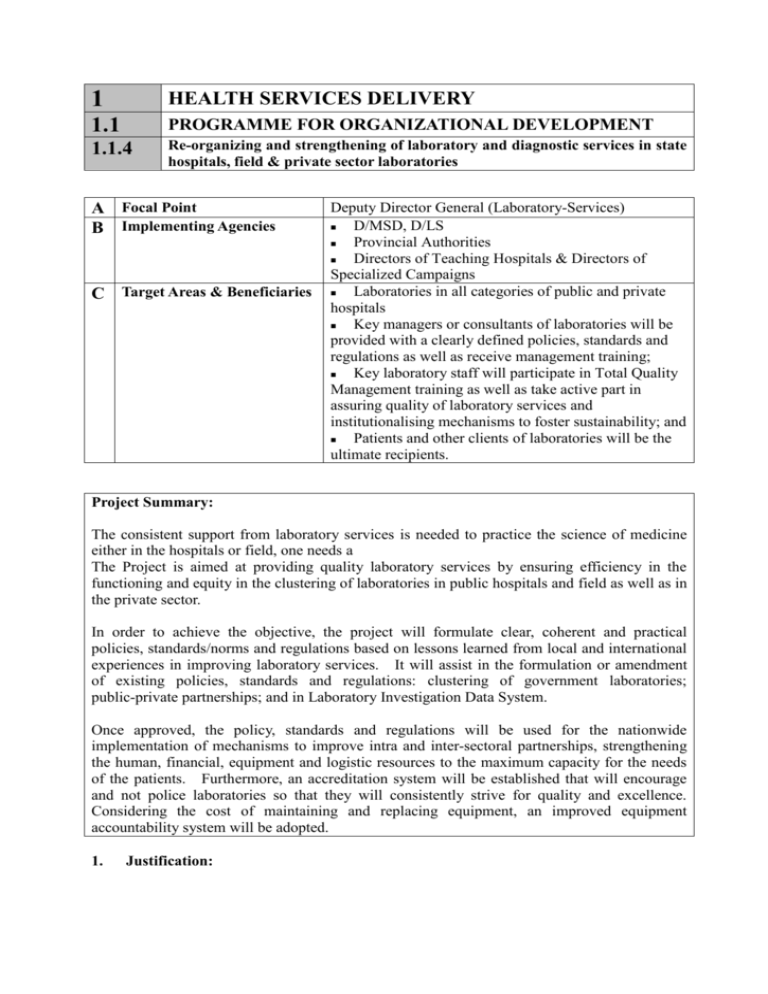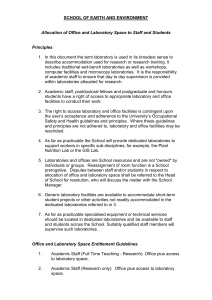Re-organising and Strengthening of Laboratory and Diagnostic
advertisement

1 HEALTH SERVICES DELIVERY 1.1 PROGRAMME FOR ORGANIZATIONAL DEVELOPMENT 1.1.4 Re-organizing and strengthening of laboratory and diagnostic services in state hospitals, field & private sector laboratories A Focal Point B Implementing Agencies C Target Areas & Beneficiaries Deputy Director General (Laboratory-Services) D/MSD, D/LS Provincial Authorities Directors of Teaching Hospitals & Directors of Specialized Campaigns Laboratories in all categories of public and private hospitals Key managers or consultants of laboratories will be provided with a clearly defined policies, standards and regulations as well as receive management training; Key laboratory staff will participate in Total Quality Management training as well as take active part in assuring quality of laboratory services and institutionalising mechanisms to foster sustainability; and Patients and other clients of laboratories will be the ultimate recipients. Project Summary: The consistent support from laboratory services is needed to practice the science of medicine either in the hospitals or field, one needs a The Project is aimed at providing quality laboratory services by ensuring efficiency in the functioning and equity in the clustering of laboratories in public hospitals and field as well as in the private sector. In order to achieve the objective, the project will formulate clear, coherent and practical policies, standards/norms and regulations based on lessons learned from local and international experiences in improving laboratory services. It will assist in the formulation or amendment of existing policies, standards and regulations: clustering of government laboratories; public-private partnerships; and in Laboratory Investigation Data System. Once approved, the policy, standards and regulations will be used for the nationwide implementation of mechanisms to improve intra and inter-sectoral partnerships, strengthening the human, financial, equipment and logistic resources to the maximum capacity for the needs of the patients. Furthermore, an accreditation system will be established that will encourage and not police laboratories so that they will consistently strive for quality and excellence. Considering the cost of maintaining and replacing equipment, an improved equipment accountability system will be adopted. 1. Justification: It is observed that due to poor supervision and supply of inadequate human, financial and logistic resources to the laboratories in hospitals, quality of most of the laboratories have deteriorated. Statistics indicate that very few hospital directors, medical superintendents and DMOO inspect the laboratories during their routine ward rounds and others try to avoid visiting the laboratories due to many problems encountered as a result of complaints made by the Consultants, patients and the laboratory staff. The situation is being aggravated further due to non-availability of Consultants in most of the laboratories to administer the routine activities and as a result the MLTT taking over the full administrative control according to their own whims and fancies. This is very clearly seen when comparison is made between two similar grade hospital laboratories with the availability of similar facilities the services provided would be of two different standards. Posting of staff, supply of equipment and chemicals do not take place according to a laid down guidelines or norms. Most of the Consultants do not have confidence on the reliability of the laboratory investigation reports and as such tend to order second investigation to be performed by a private sector laboratory. It is also observed that most of the private sector laboratories do not have qualified staff as well as calibrated equipment. Quality Control and monitoring of the routine activities of the laboratories (state as well as private) are not being performed and as such there is a doubt on the reliability of the reports issued by the laboratories. As there is no price control various laboratories in the private sector tend to charge as such re-organisation and strengthening of laboratories in the country has been identified as a project to be conducted on a priority basis. The target area for the Project is limited initially to two districts during the pilot-testing phase. Once formulated, though, the Policy on Enhancing Efficiency, Equity and Sustainability of Laboratories will address issues in all laboratories of the government and private sector. After the pilot-tests, the Project will support the strengthening of institutional capacities throughout the country in a phased approach. The following areas are intended to be addressed in the Policy, Standards or Regulations on Laboratories: 1. Pilot-testing and nationwide implementation of clustering of laboratories to achieve efficiency in conducting and reporting the results of investigations; 2. Mechanisms to optimise inter-sectoral partnerships with other government agencies, for-profit and not-for-profit private sectors; and 3. Procurement of laboratory equipment and supplies to be based on the results of a Technology Assessment process and National Policy on Equipment, Policy on Donations of Equipment. 2. Important Assumptions/Risks/Conditions: Firm policy decisions have to be taken in spite of the resistance from trade unions. Required numbers of various categories of staff to be trained and provided periodically as identified in the project. High technology, costly equipment with the consumables to be provided periodically according to the laid down norms for implementation, and all categories of staff involved in the laboratory sector need to be made aware of the project so that continuous support, co-ordination, supervision and monitoring would be voluntarily extended. The possible risks include: Initial protest from trade unions, Sabotage of equipment by the staff in laboratories, Inadequate funds and posting of staff strictly according to the needs of the country maintaining equity. 3. Project Objective: The overall goal of the Project is to improve comprehensive health services delivery and health actions, which reduce the disease burden and promote health. The specific objective is limited to improving laboratory services. Objective To provide quality laboratory services by ensuring efficiency in the functioning and equity in the clustering of laboratories in hospitals, field and private sector 4. Indicators Means of Verification % of government Mid-term evaluation laboratories that are End-of-project evaluation accredited % of patients who are at least satisfied with the improved system of delivering laboratory services Number and % of repeat investigations due to suspicious or spurious results Project Output/Product: Outputs Indicators Means of Verification Detailed Project Implementation Plan (PIP) that is used for Project Management, Monitoring & Evaluation developed Clear, coherent and practical policy, standards or norms and regulations that are used for formulation of plans for improving and accreditation of various levels of laboratories developed Motivated, skilled and competent laboratory staff at service delivery centres Adequate and appropriate equipment and consumables made available Clustered system of delivering laboratory services Public-private partnerships in the delivery and/or financing of laboratory services 5. % of PIP indicators that were used, analysed and discussed in project management, monitoring & evaluation reports % of major items in the policy, standards/norms and regulations that are being implemented % of laboratories with staff according to the approved standards % of laboratories with staff who perform well based on an approved competency checklist % of laboratories with Total Quality Circles % of randomly selected laboratories whose staff assess the equipment and consumables to be adequate and appropriate % of randomly selected laboratories strategically displaying information on the clustering system % of approved mechanisms for public-private partnerships that have achieved their objectives Related Projects: Project No. 1.1.1 Project Title Functional Rationalisation Mid-term evaluation End-of-project evaluation Mid-term evaluation End-of-project evaluation Mid-term evaluation End-of-project evaluation Mid-term evaluation End-of-project evaluation Mid-term evaluation End-of-project evaluation Mid-term evaluation End-of-project evaluation 1.1.2 1.1.5 1.1.6 1.2.1 1.2.2 1.3.4 1.3.5 1.4.1a-h 1.4.2a-j Facility Development Blood Safety Technology Assessment Medical Supplies (including drugs) Medical Equipment Total Quality Control/Management of Hospital Services Total Quality Control/Management of Promotive and Preventive Services Non-Communicable Diseases Control Programme Communicable Diseases Control Programme 6. Relevant Agencies to be Coordinated: Provincial Councils and other local authorities responsible for the pilot districts and later for all other districts Stakeholders coming from the for-profit and not-for-profit private sectors Stakeholders representing the General Practitioners and trade unions Development partners that are interested in improving laboratory services 7. Monitoring & Evaluation: Who? Focal Point Implementing Agency When? Monthly CEEESL (focal point is a member) Quarterly CEEESL (focal point is a member) Implementing Agency Annually Team including Project Focal Point, representative of the CEEESL, and an external evaluator CEEESL (focal point is a member) Implementing Agency Midterm Evaluation End-of-Pro ject Evaluation Actions? Report to the Committee for Enhancing Efficiency, Equity and Sustainability of Laboratories on the progress of Project Assess achievement of Expected Results and Process Indicators of appropriate Activities Make decisions to ensure success of Project Activities Recommend to DG, Secretary and Minister (on minor adjustment in the PIP on an annual bases and the major adjustment based on the result of the mid-term evaluation) Assess the achievement of Project Output/Product Recommend to DG, Secretary and Minister (on major adjustment in the PIP) Assess the achievement of Project Output & Objective Recommend amendment to the Policy, Standards and Regulation 8. Activities: Activities Expected Results Process Indicators 1 2 3 4 5 Formulate a laboratory policy, norms, standards and regulations Project Implementation Plan is formulated and approved Committee for enhancing efficiency, equity and sustainability of laboratories is organised Develop a laboratory/clinical audit mechanism to ensure appropriate usage of laboratory equipment Nationwide implementation of mechanisms to optimise intra and inter-sectoral partnerships Train HR to improve competencies 6 7 Purchase equipment and hardware for laboratories 8 Enhancement of Laboratory Supplies Management 9 10 11 12 13 14 15 Develop an accreditation system for laboratories Establish a communication network connecting different levels of laboratories Develop central data base on laboratory equipment Develop central data base on recommended laboratory equipment specifications Develop a mechanism for project monitoring and evaluation Develop a system for documentation, recognition and reports Carryout costing studies to determine the cost efficiency of high tech investigations in the state health sector Policies, standards and regulations are introduced printed and disseminated PIP developed Quality of laboratory services specified Identify policy development group Formulate draft policy Develop and guidelines Identify planning team Develop draft plan Appoint a work group Formulate standards Standards piloted Pilot test standards Mechanisms to optimise sectoral partnerships are implemented Adequate number of HR in place to supervise, manage and operate laboratories Hardware installed and maintained according to standards Management of laboratory chemicals and other supplies is improved Accreditation system developed Communication network established Data base developed Appoint a work group Formulate standards Data base developed All M&E activities are completed Equipment accountability system improved Costing data made available District wise implementation Identify training needs Develop training programmes Conduct TOTs Inventorized S&E Identify requirement Inventorized available supplies Develop a system Develop the system Pilot it Design the network Develop the system Design the method Develop the data base Design the method Develop the data base Design the method Design the method Develop the system Develop study protocol Identify researchers






